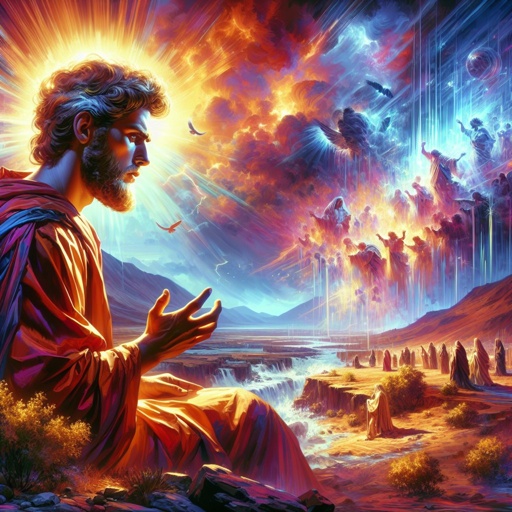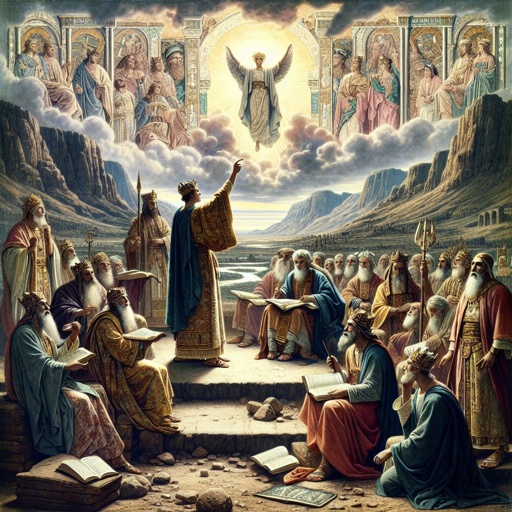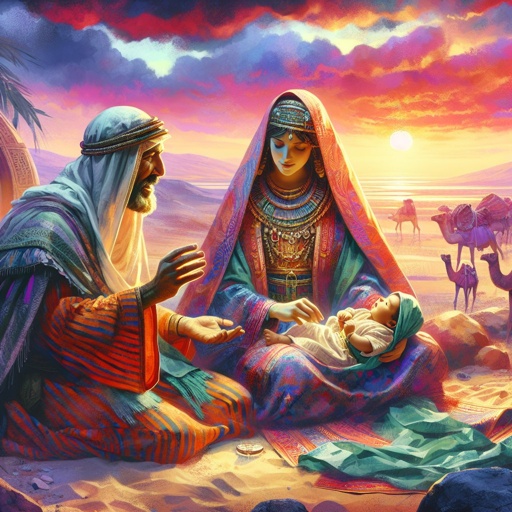What does Hosea 1:2 mean?
"The beginning of the word of the LORD by Hosea. And the LORD said to Hosea, Go, take unto thee a wife of whoredoms and children of whoredoms: for the land hath committed great whoredom, departing from the LORD." - Hosea 1:2

Hosea 1:2 - "The beginning of the word of the LORD by Hosea. And the LORD said to Hosea, Go, take unto thee a wife of whoredoms and children of whoredoms: for the land hath committed great whoredom, departing from the LORD."
Hosea 1:2 (KJV) says, "The beginning of the word of the Lord by Hosea. And the Lord said to Hosea, Go, take unto thee a wife of whoredoms and children of whoredoms: for the land hath committed great whoredom, departing from the Lord."
In this verse, we are introduced to the prophet Hosea and the message that he receives from the Lord. The Lord instructs Hosea to take a wife who is known for her unfaithfulness, and to have children with her. This unconventional command given to Hosea serves as a powerful symbol for the relationship between the Lord and the people of Israel.
The book of Hosea is a powerful and emotional portrayal of God's relationship with His people, using the prophet's own experiences to illustrate Israel's unfaithfulness and God's enduring love. In this verse, we see the beginning of Hosea's prophecy, and we are given a glimpse of the personal trials and tribulations that Hosea will face in order to bring the message of God to the people.
The theme of unfaithfulness and betrayal is central to this verse, as Hosea is instructed to marry a woman who is known for her promiscuity. This is a direct reflection of the unfaithfulness of the people of Israel, who have turned away from the Lord and embraced other gods. The use of the metaphor of marriage and infidelity serves to highlight the depth of the people's betrayal and the pain it causes to God.
The context of this verse is important to understanding its significance. At the time when Hosea received this message, the nation of Israel was experiencing political instability and moral decay. The people had turned away from the Lord and had embraced idolatry, immorality, and injustice. The Lord's command to Hosea to take a wife of whoredoms and have children of whoredoms reflects the spiritual and moral corruption that had taken root in Israel. It is a powerful and shocking metaphor that conveys the depth of the people's unfaithfulness and the severity of their transgressions.
The symbolism in this verse is rich and multifaceted. First and foremost, the marriage of Hosea to a promiscuous woman symbolizes the covenant relationship between God and His people. The unfaithfulness of Hosea's wife represents the unfaithfulness of Israel, who had forsaken their covenant with the Lord and turned to other gods. The children born of this union symbolize the spiritual offspring of Israel, who are born into a state of unfaithfulness and moral decay.
Furthermore, the symbolism of marriage and infidelity serves to convey the pain and heartache that the Lord feels as a result of Israel's betrayal. The personal experience of Hosea becomes a powerful metaphor for the emotional turmoil and agony that God experiences as a result of the people's unfaithfulness.
In conclusion, Hosea 1:2 is a powerful and evocative verse that sets the stage for the prophetic message of Hosea. The instruction given to Hosea to marry a woman of whoredoms and have children of whoredoms serves as a profound symbol of the unfaithfulness and betrayal of the people of Israel. This verse captures the emotional intensity of God's relationship with His people, and sets the tone for the rest of the book of Hosea, which is a poignant and deeply moving portrayal of God's enduring love and relentless pursuit of His people, despite their unfaithfulness.
Hosea 1:2 Artwork

Hosea 1:2 - "The beginning of the word of the LORD by Hosea. And the LORD said to Hosea, Go, take unto thee a wife of whoredoms and children of whoredoms: for the land hath committed great whoredom, departing from the LORD."

Hosea 2:1 - "Say ye unto your brethren, Ammi; and to your sisters, Ruhamah."

Hosea 1:1 - "The word of the LORD that came unto Hosea, the son of Beeri, in the days of Uzziah, Jotham, Ahaz, and Hezekiah, kings of Judah, and in the days of Jeroboam the son of Joash, king of Israel."

Hosea 2:4 - "And I will not have mercy upon her children; for they be the children of whoredoms."

Hosea 2:22 - "And the earth shall hear the corn, and the wine, and the oil; and they shall hear Jezreel."
![Use this verse to create an expressing for Black people art: Hoshĕa (Hosea) 4:1-2 TS2009
[1] Hear the word of יהוה, you children of Yisra’ĕl, for יהוה has a case against the inhabitants of the land: “For there is no truth or loving-commitment or knowledge of Elohim in the land. [2] “Swearing, and lying, and murdering, and stealing, and committing adultery have increased. And bloodshed follows bloodshed.
Create a respectful and devotional piece of Christian art depicting characters and a scene inspired by Hosea 4:1-2 from the Bible. The characters are Black, and the scene reflects their struggle against untruth, lack of loving commitment, and ignorance. The image should detail signs of adversity such as deceit and violence subtly in the background. Incorporate pointillism style, a technique predominantly used in the late 19th century, where distinct dots of color are applied in patterns to form an image. Ensure that no text or words are present in the image.](https://media.bible.art/7c5023f5-1507-4220-93ad-0f28d4b7c36c-thumbnail.jpg)
Use this verse to create an expressing for Black people art: Hoshĕa (Hosea) 4:1-2 TS2009 [1] Hear the word of יהוה, you children of Yisra’ĕl, for יהוה has a case against the inhabitants of the land: “For there is no truth or loving-commitment or knowledge of Elohim in the land. [2] “Swearing, and lying, and murdering, and stealing, and committing adultery have increased. And bloodshed follows bloodshed.

Hosea 9:2 - "The floor and the winepress shall not feed them, and the new wine shall fail in her."

Hosea 8:2 - "Israel shall cry unto me, My God, we know thee."

Hosea 4:2 - "By swearing, and lying, and killing, and stealing, and committing adultery, they break out, and blood toucheth blood."

Hosea 5:2 - "And the revolters are profound to make slaughter, though I have been a rebuker of them all."

Hosea 1:5 - "And it shall come to pass at that day, that I will break the bow of Israel in the valley of Jezreel."

Hosea 2:20 - "I will even betroth thee unto me in faithfulness: and thou shalt know the LORD."

Hosea 2:17 - "For I will take away the names of Baalim out of her mouth, and they shall no more be remembered by their name."

Hosea 2:14 - "¶ Therefore, behold, I will allure her, and bring her into the wilderness, and speak comfortably unto her."

Hosea 1:8 - "¶ Now when she had weaned Lo-ruhamah, she conceived, and bare a son."

Hosea 3:2 - "So I bought her to me for fifteen pieces of silver, and for an homer of barley, and an half homer of barley:"

Hosea 11:1 - "When Israel was a child, then I loved him, and called my son out of Egypt."
![Create a black history art piece using this verse Hoshĕa (Hosea) 4:1-2 TS2009 [1] Hear the word of יהוה, you children of Yisra’ĕl, for יהוה has a case against the inhabitants of the land: “For there is no truth or loving-commitment or knowledge of Elohim in the land. [2] “Swearing, and lying, and murdering, and stealing, and committing adultery have increased. And bloodshed follows bloodshed.
Craft an abstract digital art piece that visualizes concepts from the biblical verse Hosea 4:1-2, without showing words. The artwork captures the spirit of Black history. Depict a diverse group of individuals from different African descents, all showing varying emotions to symbolize the struggles outlined in the verse. The scenario is respectful and devotional to Christianity. Show elements like the visual metaphor of truth fading, loving-commitment dissolving, and knowledge getting lost in the background. Remember to show the escalation of negative elements like dishonesty & violence subtly. Ultimately, the artwork should encourage reflection on the verse's messages.](https://media.bible.art/17d19fe9-6f41-43dd-b8eb-987fe75986bc-thumbnail.jpg)
Create a black history art piece using this verse Hoshĕa (Hosea) 4:1-2 TS2009 [1] Hear the word of יהוה, you children of Yisra’ĕl, for יהוה has a case against the inhabitants of the land: “For there is no truth or loving-commitment or knowledge of Elohim in the land. [2] “Swearing, and lying, and murdering, and stealing, and committing adultery have increased. And bloodshed follows bloodshed.

Hosea 14:1 - "O Israel, return unto the LORD thy God; for thou hast fallen by thine iniquity."

Hosea 11:2 - "As they called them, so they went from them: they sacrificed unto Baalim, and burned incense to graven images."

Hosea 2:21 - "And it shall come to pass in that day, I will hear, saith the LORD, I will hear the heavens, and they shall hear the earth;"

Hosea 1:3 - "So he went and took Gomer the daughter of Diblaim; which conceived, and bare him a son."

Hosea 2:10 - "And now will I discover her lewdness in the sight of her lovers, and none shall deliver her out of mine hand."

Hosea 1:9 - "Then said God, Call his name Lo-ammi: for ye are not my people, and I will not be your God."

Hosea 2:16 - "And it shall be at that day, saith the LORD, that thou shalt call me Ishi; and shalt call me no more Baali."

Hosea 2:14-15 – "Therefore I am now going to allure her; I will lead her into the wilderness and speak tenderly to her."

Hosea 2:14-15 – "Therefore I am now going to allure her; I will lead her into the wilderness and speak tenderly to her."

Hosea 2:6 - "¶ Therefore, behold, I will hedge up thy way with thorns, and make a wall, that she shall not find her paths."

Hosea 13:1 - "When Ephraim spake trembling, he exalted himself in Israel; but when he offended in Baal, he died."

Hosea 10:2 - "Their heart is divided; now shall they be found faulty: he shall break down their altars, he shall spoil their images."